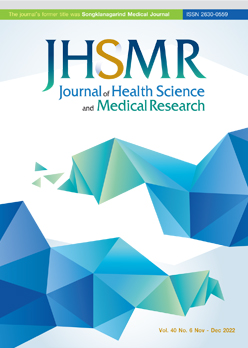Treatment Outcomes and Clinical Characteristics in Children with Amblyopia at Naresuan University
DOI:
https://doi.org/10.31584/jhsmr.2022875Keywords:
amblyopia, factors, treatment, visual outcomeAbstract
Objective: To evaluate the visual outcomes of amblyopia treatment and identify the characteristics of children with newly diagnosed amblyopia.
Material and Methods: This is a retrospective study of children newly diagnosed with amblyopia from January 2016 to December 2019. The assessments consisted of visual acuity (VA) during amblyopia treatment, and treatment effects related to age, gender, type of amblyopia, baseline Logarithm of the Minimum Angle of Resolution visual acuity (LogMAR VA), and treatment compliance. Good outcome was defined as having a best-corrected visual acuity (BCVA) with a ≥2 Snellen line improvement or a ≥20/30 VA (0.17 LogMAR) in the amblyopic eye.
Results: There were 116 amblyopic eyes, corresponding to 89 children, enrolled in the study. The most common cause of the disorder was refractive amblyopia. The mean baseline BCVA was 0.81±0.05 LogMAR. Sixty-four amblyopic eyes (55.2%) had a good treatment outcome, with a mean time for improvement of 13.61±7.89 months. The multivariable analysis in the good outcome group revealed that an age ranging from 5 to 8 years (adjusted odds ratio [aOR]=23.72, 95% confidence interval [CI]: 1.68 to 333.99) and good treatment compliance (aOR=43.09, 95% CI: 2.27-817.97) were more likely to lead to a good outcome.
Conclusion: Amblyopia has the potential to improve with early treatment and good compliance. Early detection and increased care may be necessary in patients who are non-compliant in order to achieve the best possible therapeutic outcome.
References
American Academy of Ophthalmology. Preferred practice pattern® guidelines. Pediatric ophthalmology/strabismus panel: Amblyopia. San Francisco: American Academy of Ophthalmology; 2017.
Multi-ethnic Pediatric Eye Disease Study Group. Prevalence of amblyopia or strabismus in Asian and non-Hispanic white preschool children: multi-ethnic pediatric eye disease study. Ophthalmology 2013;120:2117–24.
Multi-ethnic Pediatric Eye Disease Study Group. Prevalence of amblyopia and strabismus in African American and Hispanic children ages 6 to 72 months the multi-ethnic pediatric eye disease study. Ophthalmology 2008;115:1229-36.
Hashemi H, Yekta A, Jafarzadehpur E, Nirouzad F, Ostadimoghaddam H, Eshrati B, et al. The prevalence of amblyopia in 7-year-old schoolchildren in Iran. Strabismus 2014;22:152-7.
Chia A, Dirani M, Chan YH, Gazzard G, Au Eong KG, Selvaraj P, et al. Prevalence of amblyopia and strabismus in young Singaporean Chinese children. Invest Ophthalmol Vis Sci 2010;51:3411-7.
Handa S, Chia A. Amblyopia therapy in Asian children: factors affecting visual outcome and parents’ perception of children’s attitudes towards amblyopia treatment. Singapore Med J 2019; 60:291-7.
Santos MA, Valbuena MN, Monzon-Pajarillo AK. Visual outcomes of amblyopia therapy. Philipp J Ophthalmol 2012;37:33-8.
Soleymani A, Khafri S, Baheshmat H. Evaluating the results of amblyopia treatment in children under 9 years using full time eye closing with a gradual time reduction (1370-1392). J Babol Univ Med Sci 2016;18:29-34.
AI-Mahdi, Bener A. Outcome of occlusion treatment for strabismic amblyopia in children below 12 Years old Age. Qatar Med J 2011;20:18-20.
Kirandi EU, Akar S, Gokyigit B, Onmez FEA, Oto S. Risk factors for treatment failure and recurrence of anisometropic amblyopia. Int Ophthalmol 2017;37:835-42.
MyVision Test. Snellen - LogMAR visual acuity calculator [homepage on Internet]. [cited 2020 Jun 23]. Available from: http://www.myvisiontest.com/LogMAR.php
American Academy of Ophthalmology. Basic and clinical science course. Section 6: pediatric ophthalmology and strabismus. San Francisco: American Academy of Ophthalmology; 2019: p.53-61.
Pediatric Eye Disease Investigator Group. Treatment of bilateral refractive amblyopia in children three to less than 10 years of age. Am J Ophthalmol 2007;144:487–96.
Lin PW, Chang HW, Lai IC, Teng MC. Visual outcomes after spectacles treatment in children with bilateral high refractive amblyopia. Clin Exp Optom 2016;99:550-4.
Al Ammari HM, Al Shamlan FT. Amblyopia treatment efficacy in anisometropia. Clin Ophthalmol 2019;13:2395-402.
Pediatric Eye Disease Investigator Group. Effect of age on response to amblyopia treatment in children. Arch Ophthalmol 2011;129:1451-7.
Pediatric Eye Disease Investigator Group. A randomized trial of prescribed patching regimens for treatment of severe amblyopia in children. Ophthalmology 2003;110:2075-87.
Simonsz-Tóth B, Joosse MV, Besch D. Refractive adaptation and efficacy of occlusion therapy in untreated amblyopic patients aged 12 to 40 years. Graefes Arch Clin Exp Ophthalmol 2019;257:379-89.
Pediatric Eye Disease Investigator Group. Randomized trial of treatment of amblyopia in children aged 7 to 17 years. Arch Ophthalmol 2005;123:437-47.
Stewart CE, Fielder AR, Stephens DA, Moseley MJ. Treatment of unilateral amblyopia: factors influencing visual outcome. Invest Ophthalmol Vis Sci 2005;46:3152-60.
Woodruff G, Hiscox F, Thompson JR, Smith LK. Factors affecting the outcome of children treated for amblyopia. Eye (Lond) 1994;8:627-31.
Hussein MA, Coats DK, Muthialu A, Cohen E, Paysse EA. Risk factors for treatment failure of anisometropic amblyopia. J AAPOS 2004;8:429-34.
Vagge A, Nelson LB. Compliance with the prescribed occlusion treatment for amblyopia. Curr Opin Ophthalmol 2017;28:454-9.
Hrisos S, Clarke MP, Wright CM. The emotional impact of amblyopia treatment in preschool children: randomized controlled trial. Ophthalmology 2004;111:1550-6.
Dixon-Woods M, Awan M, Gottlob I. Why is compliance with occlusion therapy for amblyopia so hard? A qualitative study. Arch Dis Child 2006;91:491-4.
Downloads
Published
How to Cite
Issue
Section
License

This work is licensed under a Creative Commons Attribution-NonCommercial-NoDerivatives 4.0 International License.
























